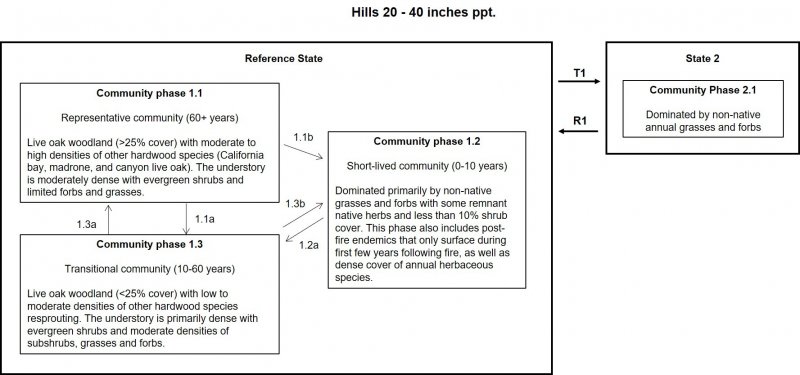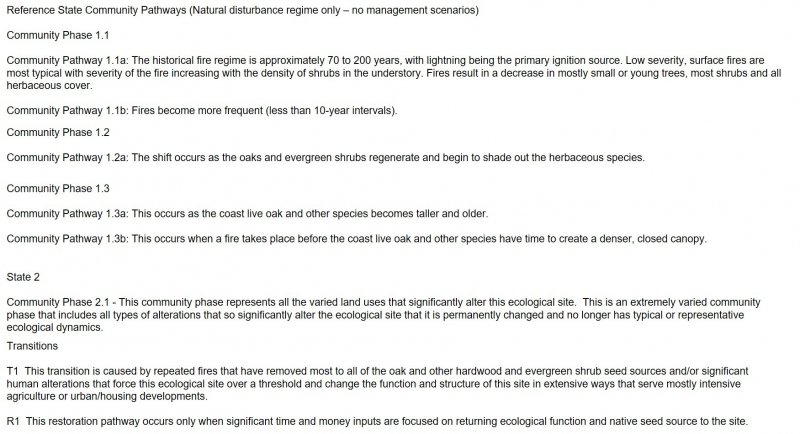Ecological site group R015XY009CAESG
Hills 20-40"ppt
Last updated: 09/07/2023
Accessed: 12/22/2025
Ecological site group description
Key Characteristics
- located on hills
- 20-40" ppt
Provisional. A provisional ecological site description has undergone quality control and quality assurance review. It contains a working state and transition model and enough information to identify the ecological site.
Physiography
This ESG is typically found on hills and upland slopes from 2 to 75 percent. Elevations typically range from 100 to 4500 feet.
Climate
The average annual precipitation in this area is typically 11 to 39 inches. Precipitation is evenly distributed throughout fall, winter, and spring but is very low in summer. Coastal areas receive some moisture from fog in summer. Most of the rainfall occurs as low- or moderate-intensity, Pacific frontal storms during the period October to May. The average annual temperature is 52 to 65 degrees F (11 to 18 degrees C), decreasing from south to north. The freeze-free period averages 275 days and ranges from 180 to 365 days, decreasing in length with elevation and from south to north.
Soil features
Soils in this ESG consist mainly of shallow to moderately deep, well and somewhat excessively drained soils that formed in material weathered from shale, sandstone, basic igneous and metamorphic rocks.
The soils that represent this ESG include:
McMullin, a loamy, mixed, superactive, mesic Lithic Ultic Haploxerolls
Millsap, a fine, mixed, superactive, thermic Typic Palexeralfs
Millsholm, a loamy, mixed, superactive, thermic Lithic Haploxerepts
Sehorn, a fine, smectitic, thermic Aridic Haploxererts
Tocaloma, a fine-loamy, mixed, superactive, mesic Typic Haploxerolls
Vegetation dynamics
This ESG covers the thermic (warm) areas of the foothills that receive more than 20 inches but less than 40 inches of precipitation each year in MLRA 15 that were at one time part of a vast complex of oak woodlands, chaparral, and perennial native grasslands. The fragmented and urbanized landscape in these low elevation foothill terraces within this MLRA that exists today makes it difficult to imagine the natural landscape prior to human development.
Live oak woodlands are common to coastal foothills of California. The woodlands do not form a continuous belt but occur in a mosaic closely associated with montane chaparral and annual grasslands. Where moisture conditions are more favorable, such as north facing slopes and canyons, or higher elevations, live oak woodlands grades into montane hardwood chaparral or sometimes montane hardwood conifer habitats. From the coast toward the hotter, drier interior portions of the north and south coast range, live oak woodland grades into blue oak woodlands, forming indistinct ecotones where the two overlap. Live oak woodlands occupy a variety of Mediterranean type climates that vary from north to south and west to east. (The climate becomes hotter and drier toward the south and east). The soils and parent material on which live oak woodlands occur are extremely variable. In San Luis Obispo County alone they are found on over fifteen different parent materials ranging from unconsolidated siliceous sand to diatomaceous earth to serpentinite to volcanic ash and basalt. Live oak woodlands generally occur on moderately to well-drained soils that are moderately deep and have low to medium fertility.
Live oak woodlands are extremely variable. The overstory consists of deciduous and evergreen hardwoods (mostly oaks 4.5-21 m (15 to 70 ft)) tall sometimes mixed with scattered conifers. In mesic sites, the trees are dense and form a closed canopy. In drier sites, the trees are widely spaced, forming an open woodland or savannah. The understory is equally variable. In some instances, it is composed of shrubs from adjacent chaparral or coastal scrub which forms a dense, almost impenetrable understory. More commonly, shrubs are scattered under and between trees. Where trees form a closed canopy, the understory varies from a lush cover of shade-tolerant shrubs, ferns, and herbs to sparse cover with a thick carpet of litter. When trees are scattered and form an open woodland, the understory is grassland, sometimes with scattered shrubs. The interrelationships of slope, soil, precipitation, moisture availability, and air temperature cause variations in structure of live oak woodlands. These factors vary along the latitudinal, longitudinal and elevational gradients over which live oak woodlands are found.
Composition of both overstory trees and understory of live oak woodland varies and reflects the environmental diversity over which this habitat occurs. In the North Coast Range south to Sonoma County, coast live oak often does not dominate. Where Oregon white oak, California black oak, canyon live oak, madrone and interior live oak dominate, the habitat is generally considered montane hardwoods. Like other oak woodlands in California, successional trends in the live oak woodlands have not been studied and remain largely unknown. Some species of deciduous oaks have not successfully reproduced for over 60 years. Evergreen oaks have been more successful and as a result appear to be gaining dominance in some areas. In other locations, it appears that coast live oak is being replaced by California bay as a result of grazing pressures and lack of successful regeneration. Indian burning in the past was important in maintaining some open stands of live oak woodland. Natural and manmade fires may still be important in some areas. Southern oak woodlands have apparently experienced an increase in periodicity of fires in recent years. Studies indicate that Engelmann oak and coast live oak are able to survive most fires.
Most live oak woodlands are comprised of medium to large trees with few seedlings and saplings, especially in heavily grazed areas. Regeneration of most oaks in the live oak woodlands has not been studied thoroughly, but it is generally considered that they do not have the serious regeneration problems found with blue oak and valley oak. However, Engelmann oak is not adequately reproducing itself for reasons similar to those of blue oak.
Live oak woodlands are comprised of slow growing, long-lived trees, so succession requires a long time. The actual time is variable and depends on local environmental conditions. Development of mature, large trees requires 60 to 80 years, and most of the trees of the live oak woodlands are at least this old. The best information available on succession in oak woodland, is historical. Since the Mission Period and especially during the last century, marked changes have occurred in the live oak woodlands of California due to the introduction of domestic grazing animals and accompanying land management practices. The change in herbaceous understory from perennial species to aggressive, introduced annuals may have resulted in young oaks being out-competed for limited supplies of nutrients and moisture. These changes have resulted in retrogressive succession in which well-developed oak woodlands regress to open woodlands or savannas and eventually to disturbed grasslands. Even ubiquitous pioneer shrubs fail to become established as successfully in disturbed grassland. Woodcutting has also had an impact and in local areas has created "stump-prairies" because oaks have not successfully reinvaded after removal. Land clearing and urban expansion have also destroyed extensive stands of live oak woodland.
Information from:
California Wildlife Habitat Relationships System
California Department of Fish and Game
California Interagency Wildlife Task Group
V. L. Holland
Major Land Resource Area
MLRA 015X
Central California Coast Range
Stage
Provisional
Contributors
Kendra Moseley
Darren Pinnegar
Darren
Click on box and path labels to scroll to the respective text.

